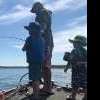Pull up a chair and get comfortable, this is going to be a little long winded........ I posted the majority of this content in another thread but I'll alter some of the content relative to your price range...... As an avid kayak angler, I feel I can offer several tidbits of information based upon personal experience and having paddled a variety of different kayaks. My first piece of advice is to browse the various kayak forums for information and reviews on different kayak styles and models. Second, check out your local kayak shop and get several hands on days to check out the various models. Third, schedule a demo or check with other kayakers in the area (the forums are great for this) and meet up with a few of them to try out theirs. If you do this, make it a point to take a notepad with you in your car, so that you can summarize your experience when you are done. All of these pieces of information will go a long way ot helping you make your decision. With that said, your initial thoughts on a SOT (Sit On Top) over a SINK (Sit INside Kayak) are correct relative to safety, but SINKs have their place and are very useful (the Wilderness Pungo 120 and Jackson Kayak Daytrippers are favorites of several people I know). The one factor that is often overlooked and in my opinion the most critical is COMFORT!!! If you sit in a kayak in the store and are uncomfortable within the first few minutes, imagine how you are going to feel after an hour? 2? 4?, etc...... The only way to truly figure all this stuff out is paddle as many different varieties as possible in different water conditions. You mentioned the OK Tetra 12 and the Redfish 12 - have you paddled or sat in either one of these kayaks? I can tell you that they are completely different from one another. Additionally, the factory seat on both kayaks is not much and will need to be upgraded which lends itself to additional funds being spent. With that said, the next step is to take into consideration your current fishing style and future desires or styles you will make an honest effort or investment in pursuing. What I mean here is what is your preferred style of fishing you do 75-80% of the time? If you are a fly fisherman, then your kayak choices may differ from someone who is a live liner and soacks minnows all day long, just like it would differ from someone who fished tidal creeks and large saltwater bays and sounds - kayak length will be a huge factor here. Here are some of the factors about you to consider: 1. Fishing equipment - are you a gear junkie that carries everything you own or can you scale back to 2-3 rods with a couple tackle trays and maybe a binder or bag for soft plastics. 2. Physical abilities - any limitations in range of movement, flexibility? Shoulder, back, knees, foot arches, etc. are all considerations that factor into which kayak to decide upon. 3. Method of transporting the kayak - do you have a truck? If not, then you might need some form of rack system for the top of your vehicle. Additional costs to keep in mind. 4. Method of storing the kayak - it is not recommended to just leave any kayak on the ground or hard flat surface. It is also not advisable to leave it out in the sun unprotected. 5. Method of launching the kayak - not all locations have a dedicated hand launch or ramp close, so you may need a cart of some form to transport your kayak to the water's edge. Also, unless you have afriend that will be fishing with you, you won't have anyone to help you load or unload the kayak! 6. Additional safety equipment required - a Class III PFD (required), a properly sized paddle, a handheld VHF radio (saltwater only), a light visible from 360 degrees, cold water gear if you plan on fishing in water temps below 60 degrees and air temps below 60, etc. 7. Other accessories - paddle leashes, rod holders, rod leashes or floats, crate or tackle storage of some form, kayak straps to secure the kayak, etc. When it comes time to start narrowing down your choices, it is time to start thinking about the various styles of kayaks and their uses. There are several models out there in your proce range that you could consider.....Keep in mind the models listed are just a sampling of ones to look at....... Jackson - Coosa, Cuda 12 or Daytripper (SINK) Wilderness Systems - Tarpon 100/120/140, Commander 120 (hybrid), Ride 115, Native Watercraft - Manta Ray 11/12 (best factory seat on the market in a SOT), Slayer 12, Ultimate 12 (hybrid) Ocean Kayak - Trident 11/13, Tetra 10/12, Scrambler or Drifter (used most likely) NuCanoe - Frontier, Classic(it really is a canoe at heart and has no scuppers or automatic bailing system like other hybrids) Mad River Canoe - basically a rotomolded canoe, not really a kayak. KC Diablo Paddlesports Emotion Mojo Moken Hurricane - Phoenix 120 or Skimmer 120 Perception (older Tarpon mold) - Pescador or Sport Caster (Gander and Dicks sell them) Pompano 120 - West Marine branded older Tarpon mold Ascend - Bass Pro Shops branded (tends to be a little heavy) Field & Stream - Dick's Sporting Goods brand (decent reviews from various forums that I have read - not sure on durability) If you are diligent in your testing sessions, you will notice that certain platforms will transfer to various bodies of water with little or no limitations. Now, if you are cost conscious, there are several options to consider: Demo kayaks - your local kayak store will have last year's models and the ones they rent out or use at demo days at a deeply discounted price. Craigslist - winter time is the perfect time to get one used - this is the time of year when people learn they need more space in the garage and are not as interested as they were in summer. You had mentioned that you would rather not rig the kayak yourself. I can tell you from personal experience that most angler models or pre-rigged models are not really laid out for individual tastes. For many folks, the location of rod holders is a personal preference that pre-rigged doesn't satisfy and cannot be changed for the most part (technically it can but requires additional plastic and a plastic welder). The best method to determine where you want rod holders is to paddle a stripped down kayak and take one rod and a jar of vaseline with you. Coat the butt cap with a dallop of vaseline before you launch. While sitting in the kayak facing forward, grab the rod and mimic the act of stowing your rod in a rod holder. This entails you trying to place the rod behind you without turning your body completely around. When you think you have it right, tap the butt end of the rod to the area of the kayak and the residue of the vaseline will remain on the hull as a reference point. When you get back to shore, you can take a permanent black marker or a small piece of duct tape and mark the spot. With that said, the best method to rig your kayak I have seen and still provide yourself with the ability to change your layout is via the use of a new kayak accessory called the GearTrac - it is a track based accessory that allows you to interchange various rod holders, fish finder mounts, camera mounts, etc around your kayak. I currently have two GearTracs installed on my hull with a third mounted atop my crate assembly. I am getting ready to install two more but will be using the new GT90 smaller profile series just released. I currently have mine setup to handle my FF, camera mount and a rod holder up front, a camera pole on the crate, and the new tracs will hold two trolling rod holders right behind my seat. The beauty of the GearTrac setup is that you can change your configuration on the water if you find something doesn't work the way you had planned. Check out the various accessories and products at the main site - http://yakattack.us You can also see how I have setup my kayak using these accessories here: http://froggin4bass.blogspot.com/2012/02/time-to-get-in-gear.html If you have any questions, don't be afraid to ask. Hope you find all of this helpful. Good luck.




